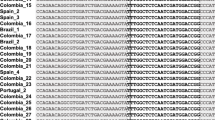The study of population frequencies of rare clinically significant alleles is a prerequisite of the development of personalized medicine. We performed genotyping of 1785 DNA samples from representatives of Russian populations according to 10 benign polymorphic markers of two genes involved in oncogenesis: 3 variants of the CDKN2A gene (rs3731249, rs116150891, and rs6413464) and 7 markers of the RB1 gene (rs149800437, rs147754935, rs183898408, rs146897002, rs4151539, rs187912365, and rs144668210). Genotyping was performed using the Illumina biochip test system. The sample covered 28 populations of the Russian Federation and neighboring countries, which were later combined into 3 groups (Asian, European, and Caucasian). The information from the ALFA (NCBI) project was used as reference for the frequencies of these polymorphisms in the Asian and European populations. It was shown that rare alleles in 8 of 10 studied polymorphic markers are presented in Russian populations of European and Caucasian origin with frequencies that are tens and hundreds of times higher than the available data for Western European populations, and in Russian Asian populations, alternative alleles of 5 markers absent in the Asian population of the ALFA project were found. In the subpopulation of Astrakhan Tatars, exceptionally high frequencies of rare alleles were identified; this requires further study.
Similar content being viewed by others
References
ALFA: Allele Frequency Aggregator [URL: https://www.ncbi.nlm.nih.gov/snp/docs/gsr/alfa/].
Cooper DN, Krawczak M, Polychronakos C, Tyler-Smith C, Kehrer-Sawatzki H. Where genotype is not predictive of phenotype: Towards an understanding of the molecular basis of reduced penetrance in human inherited disease. Hum. Genet. 2013;132(10):1077-1130. doi: https://doi.org/10.1007/s00439-013-1331-2
de Smith AJ, Walsh KM, Hansen HM, Barcellos LF, Chokkalingam AP, Jenkins RB, Wrensch MR, Wiencke JK, Metayer C, Wiemels JL. Missense SNP rs3731249 explains the CDKN2A association with childhood ALL and ahows risk allele selection in tumors with somatic CDKN2A alterations. Blood. 2014;124(21):129. doi: https://doi.org/10.1182/blood.V124.21.129.129
DeRycke MS, Gunawardena S, Balcom JR, Pickart AM, Waltman LA, French AJ, McDonnell S, Riska SM, Fogarty ZC, Larson MC, Middha S, Eckloff BW, Asmann YW, Ferber MJ, Haile RW, Gallinger S, Clendenning M, Rosty C, Win AK, Buchanan DD, Hopper JL, Newcomb PA, Le Marchand L, Goode EL, Lindor NM, Thibodeau SN. Targeted sequencing of 36 known or putative colorectal cancer susceptibility genes. Mol. Genet. Genomic Med. 2017;5(5):553-569. doi: https://doi.org/10.1002/mgg3.317
Dyson NJ. RB1: A prototype tumor suppressor and an enigma. Genes Dev. 2016;30(13):1492-1502. doi: https://doi.org/10.1101/gad.282145.116
Ferru A, Fromont G, Gibelin H, Guilhot J, Savagner F, Tourani JM, Kraimps JL, Larsen CJ, Karayan-Tapon L. The status of CDKN2A alpha (p16INK4A) and beta (p14 ARF) transcripts in thyroid tumour progression. Br. J. Cancer. 2006;95(12):1670-1677. doi: https://doi.org/10.1038/sj.bjc.6603479
Hassler M, Singh S, Yue WW, Luczynski M, Lakbir R, Sanchez-Sanchez F, Bader T, Pearl LH, Mittnacht S. Crystal structure of the retinoblastoma protein N domain provides insight into tumor suppression, ligand interaction, and holoprotein architecture. Mol. Cell. 2007;28(3):371-385. doi: https://doi.org/10.1016/j.molcel.2007.08.023
Sen M, Akeno N, Reece A, Miller AL, Simpson DS, Wikenheiser-Brokamp KA. p16 controls epithelial cell growth and suppresses carcinogenesis through mechanisms that do not require RB1 function. Oncogenesis. 2017;6(4):e320. doi: https://doi.org/10.1038/oncsis.2017.
Uchida C. Roles of pRB in the regulation of nucleosome and chromatin structures. Biomed. Res. Int. 2016;2016:5959721. doi: https://doi.org/10.1155/2016/5959721
What is ClinVar? [URL: https://www.ncbi.nlm.nih.gov/clinvar/intro/].
Author information
Authors and Affiliations
Corresponding author
Additional information
Translated from Byulleten’ Eksperimental’noi Biologii i Meditsiny, Vol. 172, No. 9, pp. 347-355, September, 2021
Rights and permissions
About this article
Cite this article
Olkova, M.V., Balanovsky, O.P. Analysis of the Frequency of 10 Polymorphic Markers of CDKN2A and RB1 Genes in Russian Populations. Bull Exp Biol Med 172, 352–358 (2022). https://doi.org/10.1007/s10517-022-05391-9
Received:
Published:
Issue Date:
DOI: https://doi.org/10.1007/s10517-022-05391-9




